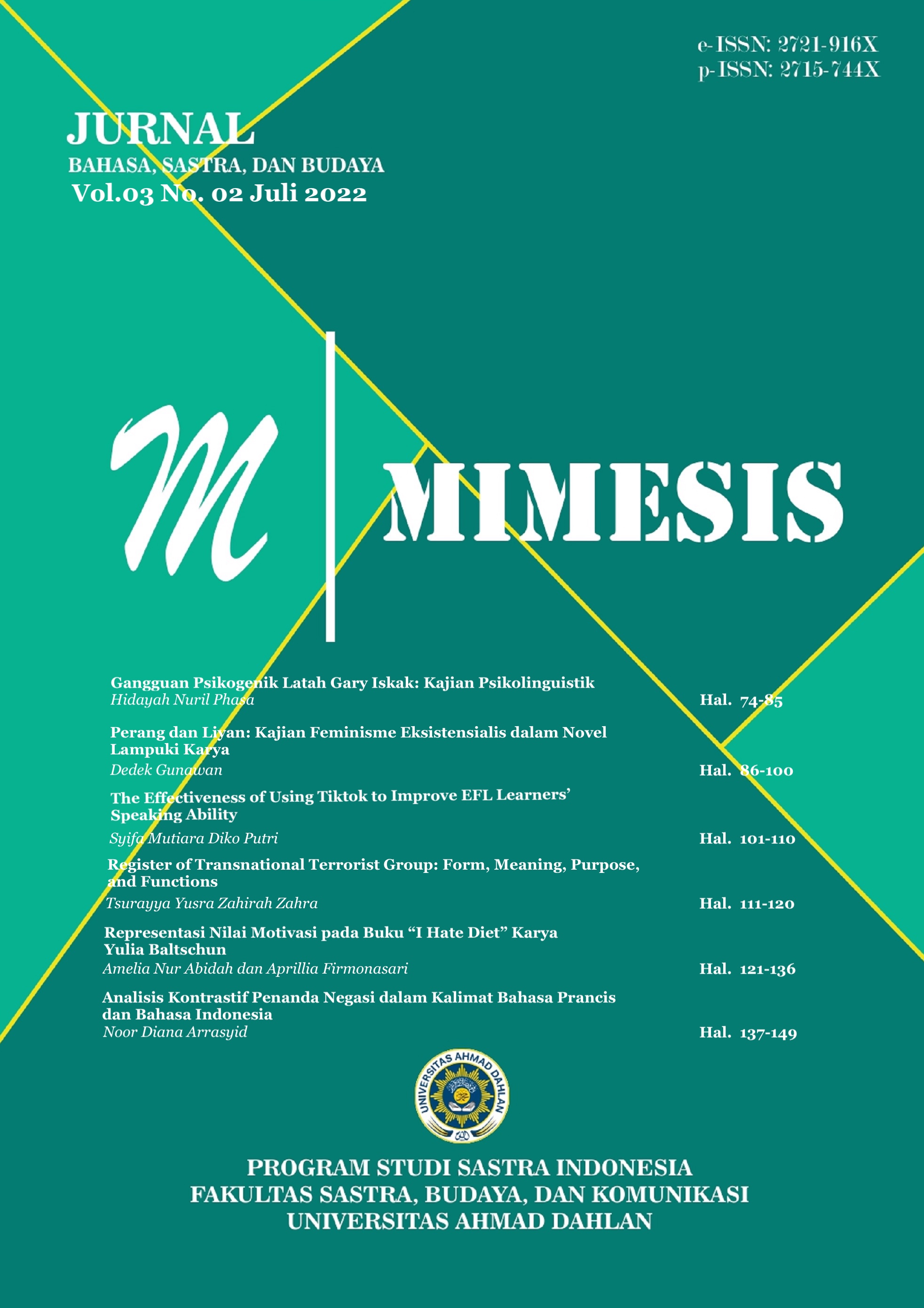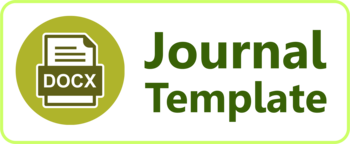ANALISIS KONTRASTIF PENANDA NEGASI DALAM KALIMAT BAHASA PRANCIS DAN BAHASA INDONESIA
DOI:
https://doi.org/10.12928/mms.v3i2.6241Keywords:
Indonesian, French , Sentence , Contrastive , NegationAbstract
This study examines the peculiarities, similarities, and differences of negation patterns in French and Indonesian sentences. The data analyzed are declarative, interrogative, and negative imperative sentences taken from the Leipzig Corpora Collection. The analysis results found that there are similarities in the formation of negation markers in French “ne … jamais” and Indonesian negation markers “tidak pernah”. The equivalence also appears in the arrangement of negative imperative sentence markers, which are formulated with negative ne+adverbs pas+verb and jangan+verb. Regarding the differences, the negation marker in French is present in two mandatory components, while in Indonesian, it is marked with one marker. There is even more variety of negations in French. In Indonesian, there is a standard rule between the combination of negation markers and the type of predicate in a sentence, but French tends to be more accessible. The formation of past and passive negative sentences is also different. Finally, in negative imperative sentences in French, the verb that is negated must be conjugated according to the subject, but in Indonesian, this is not the case.
References
Alwi, H., Moeliono, A. M., Lapoliwa, H., Sasangka, S. S. T. W., & Sugiyono. (2017). Tata Bahasa Baku Bahasa Indonesia (Edisi keempat). Jakarta: Badan Pengembangan dan Pembinaan Bahasa Kementerian Pendidikan dan Kebudayaan. Diambil dari http://repositori.kemdikbud.go.id/16351/
Badudu, J. S., Ramlan, M., Keraf, G., Moeliono, A. M., Silitonga, M., & Kridalaksana, H. (1976). Pedoman Penulisan Tata Bahasa Indonesia. Jakarta: Pusat Pembinaan dan Pengembangan Bahasa. Diambil dari http://repositori.kemdikbud.go.id/3293/1/PEDOMAN%20PENULISAN-TATA%20BAHASA%20INDONESIA.pdf
Cartoni, B., & Lefer, M.-A. (2011). Negation And Lexical Morphology Across Languages: Insights From A Trilingual Translation Corpus. Poznań Studies in Contemporary Linguistics, 47(4), 795–843. https://doi.org/10.2478/psicl-2011-0039
Creswell, J. W., & Creswell, J. D. (2018). Research design: Qualitative, quantitative, and mixed methods approaches (Edisi Kelima). Los Angles: Sage.
Crystal, D. (2008). A Dictionary of Linguistics and Phonetics (Edisi keenam). London: Blackwell Publisher.
Dubois, J., & Dubois-Charlier, F. (1970). Éléments De Linguistique Français: Syntaxe. Paris: Libraire Larousse.
Harimurti Kridalaksana. (1982). Kamus Linguistik. Jakarta: PT Gramedia.
Hariri, T., Wijana, I. D. P., Suhandano, Sutrisno, A., Kesuma, Y. T. M. J., Sajarwa, & Hendrokumoro. (Forthcoming). Metode Penelitian Bahasa. Yogyakarta: Penerbit Fakultas Ilmu Budaya UGM.
Ibekwe, H. A. (2020). Analyse Contrastive De L’emploi De La Negation En Français Et En Yoruba. Journal of Languages, Linguistics and Literary Studies, 9(4), 62–70.
Kamus Besar Bahasa Indonesia. (2016). Jakarta: Pusat Bahasa Kementerian Pendidikan Nasional. Diambil dari https://kbbi.kemdikbud.go.id/
Leipzig Corpora Collection—French. (2021). Diambil 3 Desember 2021, dari https://corpora.uni-leipzig.de/en?corpusId=fra_mixed_2012
Leipzig Corpora Collection—Indonesian. (2021). Diambil 12 November 2021, dari https://corpora.uni-leipzig.de/en?corpusId=ind_mixed_2013
Stragier, N. (2016). Ne Retournez Jamais Chez Une Fille Du Passé. Paris: Syros.
Sudaryono. (1993). Negasi dalam Bahasa Indonesia: Suatu Tinjauan Sintaktik dan Semantik. Jakarta: Pusat Pembinaan dan Pengembangan Bahasa.
Sulaiman, M. (2020). A Contrastive Analysis Between English And Indonesian Negations: A Case Of Negative Markers. English Community Journal, 4(1), 33–44. https://doi.org/10.32502/ecj.v4i1.2603
Syafar, D. N. (2016). Negasi Dalam Bahasa Indonesia dan Bahasa Inggris. Jurnal Arbitrer, 3(1), 1–11. https://doi.org/10.25077/ar.3.1.1-11.2016
Tatang Hariri. (2021). Metode Penelitian Linguistik Kontrastif.
Verhaar, J. W. M. (2016). Asas-Asas Linguistik Umum (Cetakan kesembilan). Yogyakarta: Gadjah Mada University Press.
Wijana, I. D. P. (2021). Linguistik Kontrastif (Edisi pertama). Yogyakarta: TS Publisher.
Downloads
Published
Issue
Section
License
Copyright (c) 2022 Noor Diana Arrasyid

This work is licensed under a Creative Commons Attribution-ShareAlike 4.0 International License.
License and Copyright Agreement
In submitting the manuscript to the journal, the authors certify that:
- They are authorized by their co-authors to enter into these arrangements.
- The work described has not been formally published before, except in the form of an abstract or as part of a published lecture, review, thesis, or overlay journal.
- That it is not under consideration for publication elsewhere,
- That its publication has been approved by all the author(s) and by the responsible authorities tacitly or explicitly of the institutes where the work has been carried out.
- They secure the right to reproduce any material that has already been published or copyrighted elsewhere.
- They agree to the following license and copyright agreement.
Copyright
Authors who publish with Mimesis agree to the following terms:
- Authors retain copyright and grant the journal right of first publication with the work simultaneously licensed under a Creative Commons Attribution License (CC BY-SA 4.0) that allows others to share the work with an acknowledgment of the work's authorship and initial publication in this journal.
- Authors are able to enter into separate, additional contractual arrangements for the non-exclusive distribution of the journal's published version of the work (e.g., post it to an institutional repository or publish it in a book), with an acknowledgment of its initial publication in this journal.
- Authors are permitted and encouraged to post their work online (e.g., in institutional repositories or on their website) prior to and during the submission process, as it can lead to productive exchanges, as well as earlier and greater citation of published work.











